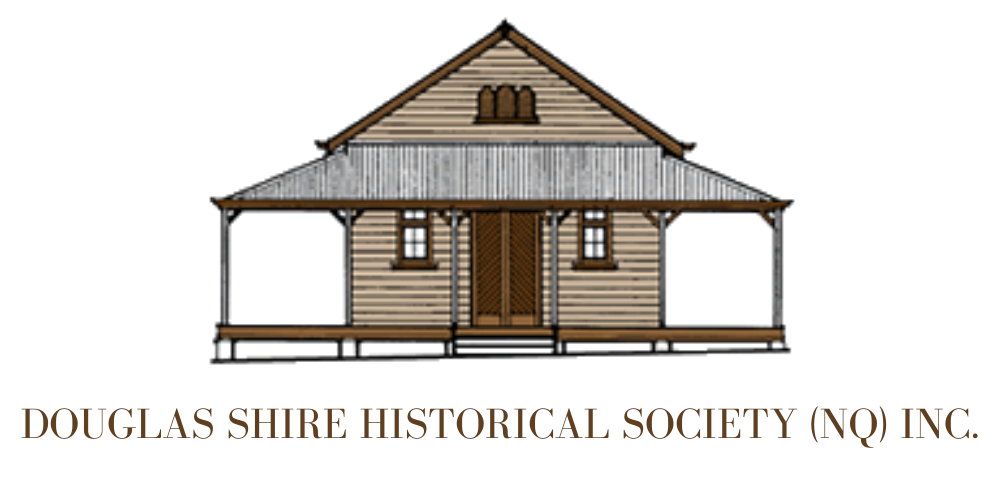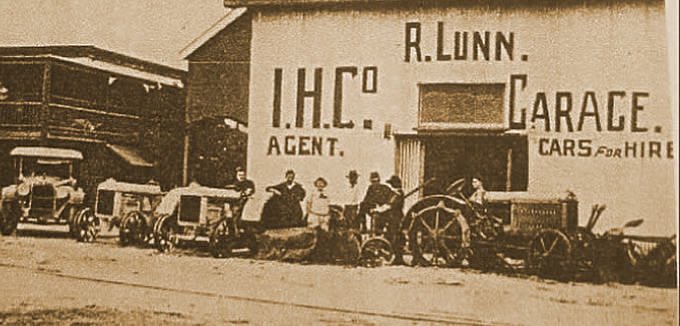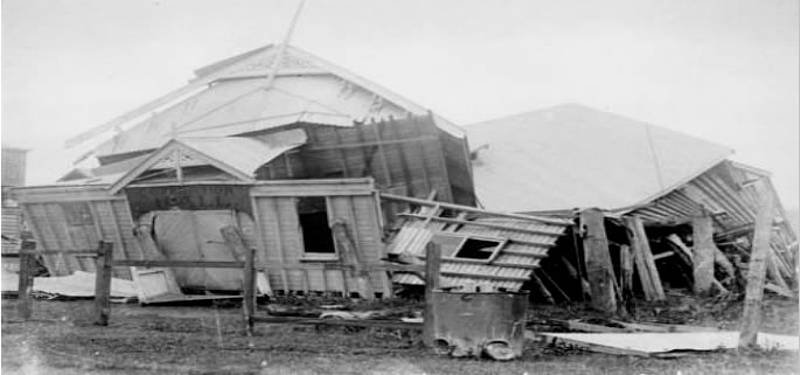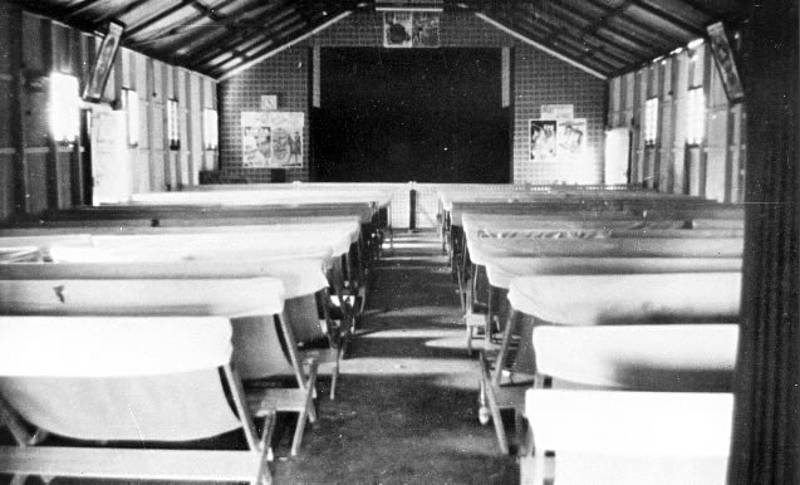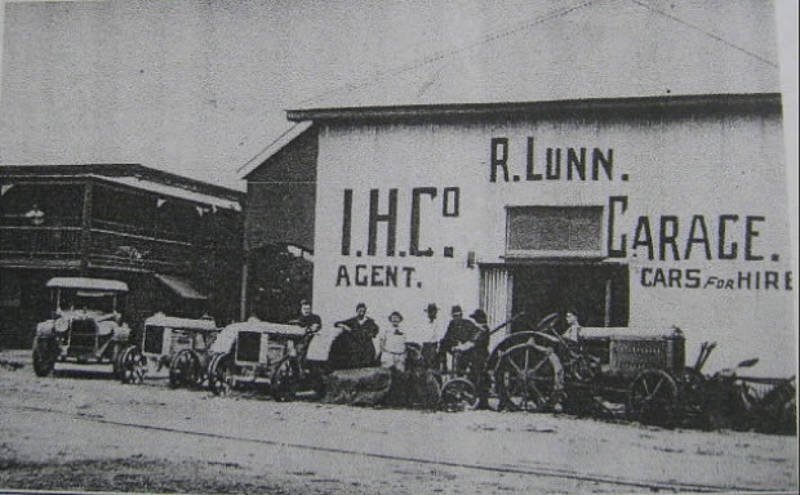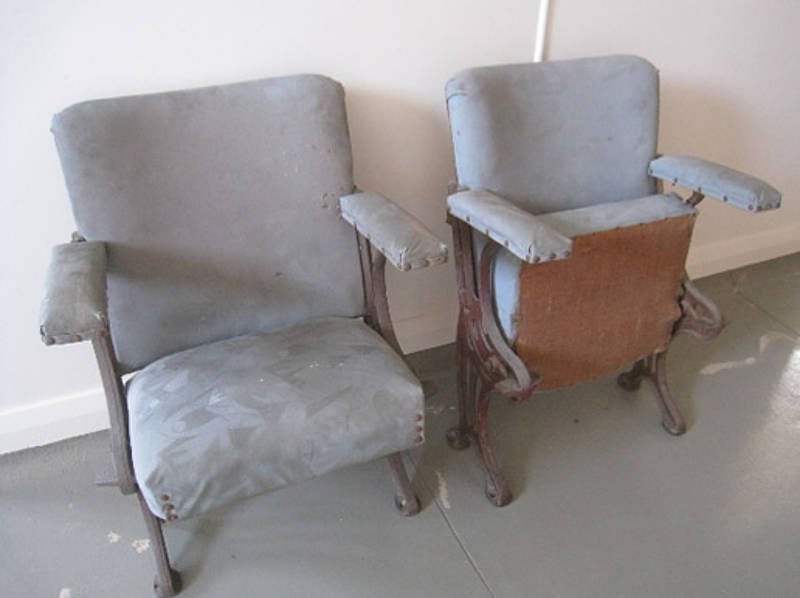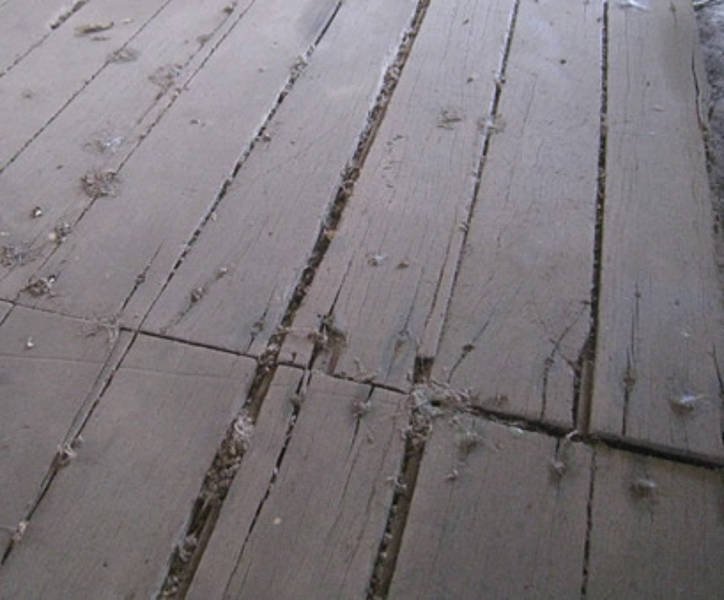Photoplay Theatre
Richard (Dick) Lunn’s Coronation Hall was built in 1910 next to the Post Office Hotel in Mill Street, Mossman, where he was the licensee with his wife Dolly.
Dick officially purchased the adjoining land from early Mossman pioneer William Henry Buchanan on 30 September 1910 but his architect Mr C. D. Lynch had already called for tenders to build the hall in April that year. (Cairns Post 26 April 1910)
Measuring 85 ft by 30 ft (25m x 9m) with a 15 ft (4.5m) stage and proscenium 13 ft (4.5m) high, it was built of timber with an iron roof and was raised on blocks. The floor area was 50ft x 30ft (15.25 x 9m) with dressing rooms backstage and a vestibule and cloakrooms at the front.
The side walls of the hall were about 14 feet high. A large lantern in the roof provided for light and ventilation and four windows at each side of the hall assisted with ventilation in the hot climate, stated the Port Douglas and Mossman Record of May 12, 1910.
Dick was obviously inspired by the impending Coronation of George V and Queen Mary, grandson of Queen Victoria. George succeeded Edward VII on 10 May 1910 and the Coronation took place on 22 June 1911.
In the Port Douglas & Mossman Record of Aug 2 1910 the hall is three weeks away from being ready, with the framework up, and the roofing, flooring and weather boards being put on.
One of the very first performances was given on 10 September 1910 by eighteen-year-old Gladys Moncrieff from Townsville, who became a famous Australian singer. She appeared with her Star Pictures and Singers Company (Port Douglas and Mossman Record 13 Sept 1910). Mr Moncrieff owned a projector possibly screened some moving pictures during the evening.
Only six months later, the devastating cyclone of 16 March 1911 which destroyed much of Port Douglas, tore apart Lunn’s new hall.
The next month, George Nielson was contracted to rebuild the hall, and the annual Bachelor’s Ball was held there on July 6th 1911. Dick was back in business.
The 1912 June 12 Port Douglas and Mossman Record announced that Dick and Ernest C. Hannaford, who had a photographer’s studio further up Mill Street, were arranging for picture shows with their own ‘apparatus’ in the hall, with occasional visits to Port Douglas. Charles May, the local butcher was also attached to the partnership.
They named their enterprise the Northern Photoplay Company and on 17 August 1912, they showed a number of films including “Love and Friendship”, a very popular drama. (Port Douglas and Mossman Record 20 Aug 1912.) The screen was erected on the stage and patrons sat on canvas chairs and wooden forms which could be pushed aside for dancing.
Although travelling showmen visited various halls, the Photoplay became the first permanent motion picture theatre in the district and operated initially by limelight and acetylene gas. (Cairns Post 4 April 1960) Limelight was used as a bright light to project the film images onto the screen by burning a mixture of potash and manganese through ether and onto a small block of lime, wrote Julie James Bailey in her 1995 paper for SLQ “Going to the Pictures”.
The hand-cranked projector sat on a large table in the middle of the hall with a gas generator beside it. The generator would make strange noises and was quite flammable.
Dick’s company invested again in 1913 and imported an electric lighting plant. (Port Douglas and Mossman Record 15 July 1913)
The hall was used for all types of entertainment as well as screening moving pictures. Card nights, political speeches, benefit concerts and balls were some other attractions for the residents of the district, who arrived at first on foot or by horse. During World War I, recruitment drives and repatriation fund-raisers were held in Lunn’s Hall.
In 1918, a side verandah was added and later enclosed to form a balcony, which was popular with people playing card games like euchre.
Dick Lunn continued to operate his garage from the front of the hall, selling cars, farm equipment and repairing engines.
The only reference to the picture show being in the open-air comes in the Cairns Post of 29 Sept 1919 with a mention of the audience sitting in the drizzle.
After the sale of their hotel next door in 1925, Dolly Lunn took over running the Candy Bar or ‘snackshop’. She made ice-cream in a room under the stage once a week with the help of many local children who collected the ice from the butchers, then churned the cream in return for free admission.
Silent films became longer and more popular, and as technology improved, the Talkies were a natural progression. But they appeared at the same time as the Great Depression (1929-1931) and the new projection equipment was very expensive. However Dick Lunn believed in his picture show and purchased the best equipment he could, Western Electric.
He made major renovations to his hall and added an awning over the footpath (Cairns Post 1929 Nov 26) and raised the roof. The projection box was on the street side above the garage.
The Chairman of the Douglas Shire Council, Mr S. B. Andreassen, performed the official opening of the Talkies at the Photoplay on 5 May 1931, reported the Cairns Post of 11 May 1931.
The entrance to the picture show was up the stairs on the hotel side, or left hand side, of the hall. Dolly Lunn sold tickets through the garage window just below the stairs and Dick Lunn stood at the top, often with classical music playing, tearing the tickets. The Photoplay could seat about 560 people and most patrons sat in canvas seats on floor level, which were laced together in groups of six. Right at the front were three or four rows of wooden forms where the aboriginal people sat. Locals said there was never any intended discrimination, and indigenous people said that was just where they sat each visit. Sometimes they came in the back door.
The new balcony or dress circle had brown leather seats with pull-down cushions for those who could pay a bit more for admission.
The timber wall nearest the hotel had open lattice from half way up to let in the breeze and heavy canvas curtains were rolled down to keep out the light. There were fire stairs on the opposite timber wall and many times kids would line up there to peer through the open casement windows without paying.
Luckily the Photoplay survived the huge fire which destroyed the Post Office Hotel next door in 1931 (Cairns Post 1931 Jan 29) and it also survived the 1934 cyclone which damaged many Mossman buildings.
Dick’s son Phil, known as P.S., purchased the garage from his father in 1935 but continued as projectionist at the Photoplay until he went away to the War in 1942. The Photoplay remained open and screened Cinesound and Movietone newsreels which brought vivid images of the fighting to Mossman. What an important service this was for an isolated country town, before television or the internet.
Sessions always screened two feature films and often the main feature after Intermission was in colour. Beginning with God Save the King, in the first half there were the newsreels, cartoons like Tweety Pie and Tom and Jerry, a comedy short from Pete Smith or Joe McDoakes or perhaps a travelogue. Advertising slides were shown during Intermission, backed by music from a 78 record player.
Going to the pictures became a firm weekly outing for most families in the district, and the weekend sessions were usually a sell-out.
The roof was raised again, and in 1946, Dick Lunn sold the Photoplay to Far Northern Theatres who already operated cinemas in Cairns, Mareeba, Atherton and Babinda. Dick was 75 years old and had been a motion picture exhibitor for 34 years.
Gordon Carroll was the projectionist from 1947 and became manager about 1950. Ron Johnston began work straight from school in November 1949 and was his assistant projectionist or “spool boy”. Part of his job was to rewind the film, and thread the Westrex projectors. He was also the “poster boy”, riding around Mossman on his pushbike with a pot of glue on the handlebars, putting up posters for coming attractions. A good place was the corrugated iron fence by the Exchange Hotel in Front Street.
The films were now on a circuit with Far Northern Theatres, and Donnie Gray who was assistant projectionist from 1954 said the films would travel from Cairns to Kuranda, Malanda, Atherton, Mareeba, Mossman and back to Cairns. They arrived in Mossman by White Cars transport.
Donnie remembers the projectors were operated with two carbons-like welding rods and in the book “Let’s go the Pictures in Mossman” he relates how he used to fix the film when it broke.
By 1952 the building was falling into disrepair (Cairns Post 1 Oct 1952) and after writing many times to Far Northern Theatres, by 1954 the Douglas Shire Council wanted it condemned. (Cairns Post 7 April 1954) The Roxy at Atherton burnt down in 1947 (Cairns Post Thurs 5 June 1947) so they were obviously trying to protect the public.
But Far Northern Theatres continued screening at the Photoplay until June 1956 when the brand new Rex Theatre opened.
The Photoplay screened its last films on 26 and 27 June 1956 showing “Bounty Hunter” with Randolph Scott and ”Flamefoot” with Ronald Howard. In the one-day changeover, the projectors were taken to the Rex and opening night was 29 June. Manager Keith Traine oversaw the transition.
The Photoplay was one of the oldest cinemas in Queensland, operating for 44 years.
Far Northern Theatres sold the building in 1957 to Bertram Barnard, a plumber.
Because of its bad condition, local man Ken Ziegler remembers cutting the hardwood timber floor into panels and using them as flooring in a shed in Daintree Road in the late 1950s, where they remain. Ken also used timber for rafters in his place in Wonga.
The Barnards sold the building in 1964 to Maurice Bertram “Jack” Fischer a builder, By the time he took over only the front two-storey section remained and the projection room upstairs had been turned into living quarters.
Jack built a concrete brick extension on the back where the auditorium was, and operated a supermarket there until 1988.
It is still a supermarket today and probably some of the two-storey structure is the original from 1930.
For more photos and information, read “Let’s Go to the Pictures in Mossman” available from DSHS.
Lunn's Coronation Hall - Cyclone damage 1911. (John Oxley Library, State Library of Queensland)
The Photo-Play and PS Lunn’s garage after 1945. (A, McArthur. Straightened by Robyn Ayers)
The Coronation Theatre, Gargett, Qld with canvas seats (SLQ)
John Oxley Library SLQ.) c.1935
(Annette McArthur)
These are the only two seats remaining, and were recovered in blue for use in the Mossman Masonic Lodge after the Photoplay closed in 1956.
Because of its bad condition, local man Ken Ziegler remembers cutting the hardwood timber floor into panels and using them as flooring in a shed in Daintree Road in the late 1950s, where they remain. Ken also used timber for rafters in his place in Wonga.
The Photoplay site, 30 Mill Street, now the Welcome Mart 2013

